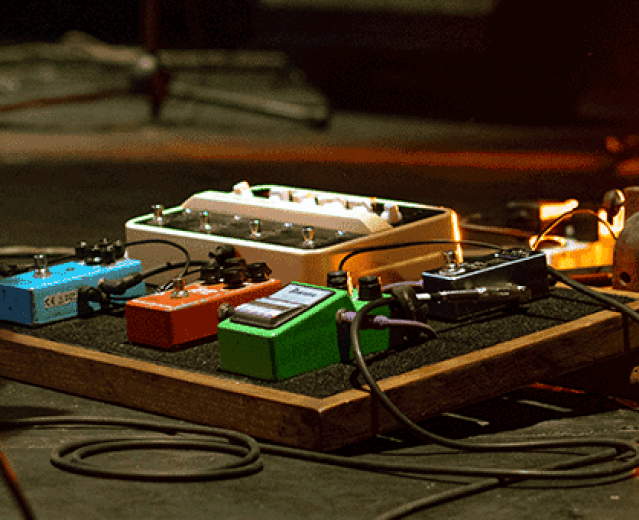Finding out the different types
of analog distortion/overdrive pedals may seem hard, but facilitation it is actually
possible if you divide them in few large families based on their circuit styles.
Before continuing, we assume
that the reader already knows the differences among various
pedal effects for guitar and bass players, as well as the topics covered in other
articles of the Soundsation
blog about: effect chain organization, involved electric quantities, kinds of buffer and bypass, amps/effects interaction.
We
are going to deal with the various families of distortion pedal effects (also called stompboxes) in a succinct and comprehensible way, giving general indications
of which ones best suit our needs.
Therefore,
in this article we will focus on dynamic pedal effects such as overdrive and distortion ones, all
designed to square the wave!
Large families of distortion pedals
To
better know distortion effects, we can divide them in three big families:
- transistor
overdrives
- integrated
circuit overdrives
- tube
overdrives.
Premise
Before continuing, it
is worth saying that all distortion effects do the same thing: they square the electric signal wave that comes from the electric guitar they are connected to (clipping).
The different names that were assigned to these pedals
through time have commercial reasons:
suggesting a desired sound, proposing a sensorial suggestion or a link to famous
artists, popular music genres, vintage products, giving them unique identification
in the increasingly crowded commercial panorama.
That said, their function is to amplify the electric signal
until its squaring is obtained, the effect guitarists perceive as a pleasing distortion.
Any kind and model of pedal get this result in slightly different ways, using circuit
enrichments, mainly in the tone network, that give a certain tonal personality.
I am going to refer generically to them as overdrives.
Transistor overdrives
Fuzz is a type
of transistor overdrive, in which the gain that is necessary to amplify the
input signal up to the clipping is obtained with two, three or four transistors and, sometimes, diodes. In the beginning, germanium transistors were used, later
substituted with silicon ones, that
were more affordable and stable from an electric and thermal point of view.
With the advent of integrated circuits, operational amplifiers (op-amps) were
used in fuzz design, trying to maintain the sound dimension that word implied. So
there are fuzzes and similar effects based on germanium
or silicon, transistors or op-amps, with or without diodes. There are not fixed
rules, but some purists think that a true
fuzz should be made with transistors and no diodes. We are going to develop
this topic in a specific article. So, what can we expect from each fuzz kind, besides
their shared progressive cleaning up in sound as the gain is reduced?
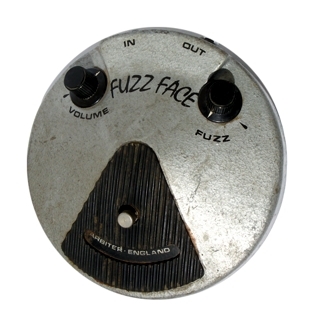
Germanium fuzz: quick
distortion, massive sound, grainy or fuzzed
lows, smooth highs, sometimes they are difficult to control and show variable
behaviour according to power supply and temperature (in vintage models). Let us
remind ourselves that the power of certain frequencies it is not always so
noticeable in the live mix of a band, unless we are playing in a power trio. Example: early Arbiter Fuzz Faces since 1966.
Silicon fuzz: solid
sound with prominent mids and trebles, controllable lows, flute-like distortion
in the best models, effectiveness through a live mix. The most common example
is the (Dallas) Arbiter Fuzz Face after 1968. I should also mention the Electro-Harmonix
Big Muff since ’69 till today; but, being
their circuit also based on diodes, purists do not consider them actual fuzzes.
The same is true for Big Muff versions that use an op-amp instead of transistors.
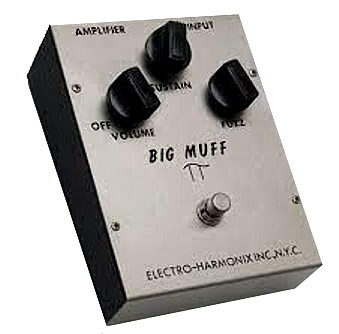
Why choose a fuzz
Fuzz distortion is extreme (but mostly unsuitable for metal) and produces strong vintage colours. Over
the years, fuzzes have been living glory and neglect times, but today they are highly
in use again, often in alternative ways by a new guitar players generation.
Aggressive, iconoclast, but also sophisticated and lyrical in the hands of an
inspired soloist. A fuzz is necessary to reproduce iconic sounds of rock, perfect
with a Strat style guitar and a British style amp, great
with the bottleneck. A
fuzz in your arsenal is an imperative if you are a rock guitar player, though it
is not your main distortion pedal. Considering that the circuit must dialogue with the guitar pickup by
design, it is very important that the fuzz (as the wah) is placed as first on
the pedalboard,
directly connected to the guitar cable, unless
there are only hard bypass pedals in the midst.
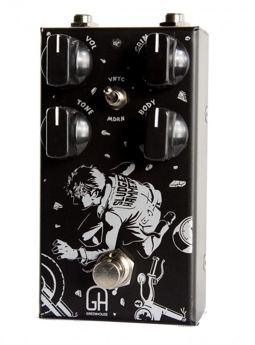
Transistor
overdrives (not fuzzes)
Transistors are used in some distortion pedals that
are not fuzzes. They often have names that contain words such as drive
or blues
that can mislead. The aim is creating a cascading
stages of gain by means of transistors;
the sound effect is aggressive and defined at the same time. Distortion stays attached to notes, allowing a neat attack
and a clean fast performance with alternate picking. Examples: 1995 Boss BD-2, early Boss DS-1 from the end of the ’70s (op-amps were used later) and
generally some distortion pedals that promise to simulate the sound of a British amp.
IC overdrives
Instead of discrete transistors, integrated circuits are used in these distortion effects. I shall
refer to integrated circuit (ICs) with the popular op-amp term (operational
amplifier).
Op-amp based fuzzes are quite rare and have a heavy rock sound with more gain than
transistor ones, very aggressive, prone to harshness in the middle to high
frequency range. Nevertheless these fuzzes have made the fortune of rock bands as
the Smashing Pumpkins. Example:
Electro-Harmonix Op-Amp Big Muff Pi.
Having op-amp fuzzes been mentioned, let us focus on op-amp
overdrives. They substantially are of two kinds: soft-clipping and hard-clipping.
Soft-clipping op-amp
One of the most known and popular categories of soft-clipping overdrives is the various tube and various screamer
one, with op-amp and diodes based circuits. 1977 Boss OD-1 was the first model of this type. It featured a 3403 quad op-amp.
1979 Ibanez TS808 was the second one,
and it is still the most popular and copied. It featured a 4558 double op-amp, around
which a certain mythology has been generated. The famous Japan Radio Company
(JRC) 4558 IC was used in vintage Tube
Screamers, and later substituted with analogous chips made by other companies.
It is featured in a multitude of pre-amp circuits in different effects and
solid state amplifiers of any level. In both Boss and Ibanez cases the real
core of their sound – warm, compressed, emphasized
on the mids and anything but transparent
– resides in brilliant designs more than in their cheap parts. Subsequent steps
of compression, mild clipping, low
frequencies de-emphasis and middle emphasis are aimed at simulating a saturated
tube amp and easily cutting in the mix.
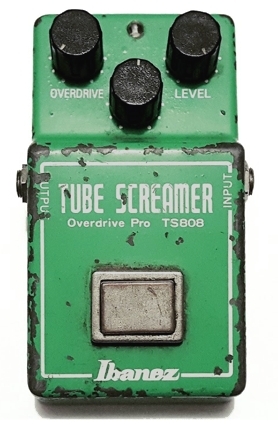
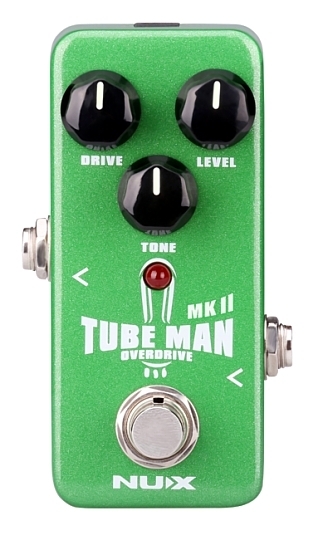
Pedals such as the 1991 Marshall Blues Breaker and its emulators offer a soft-clipping sound too, but more direct, much
less EQ manipulated and decidedly more transparent.
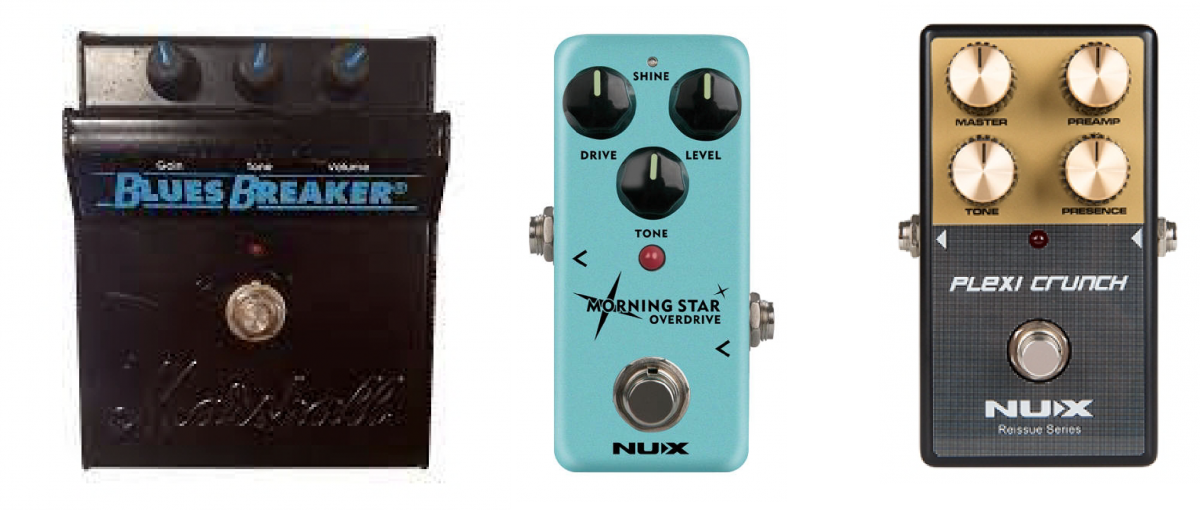
Hard-clipping op-amp
In this category we can find distortion pedals in which
single and double, not particularly famous op-amps are used to roughly square the
whole guitar signal with no frills. In fact they produce the typical ’70s rock sound that sometimes is on the edge of a fuzz tone. Classical examples are
the MXR Distortion+, the DOD Overdrive Preamp/250 and the ProCo Rat, all presented in 1979.
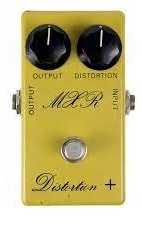
The outsider
1994 Klon Centaur by Bill Finnegan is
among the most noted and sought after overdrives. This pedal features circuit
section diversified power supplies and
a double gain potentiometer that always retains an amount of clean signal in the distorted output, thus permitting extraordinary
dynamics and definition. Its diodes are germanium ones, but we must consider that
they do not come to play until the gain knob is well over half the run; otherwise,
the behaviour is that of a clean booster.
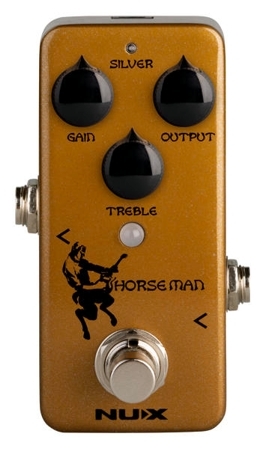
The are also particular C-MOS (double MOS-FET) IC based overdrives such as the 1978 Electro-Harmonix
Hot Tubes and the ‘90s Way Huge Red Llama. They simulate a tube amp in a
sort of analog modeling circuit. The sound
varies from boost to nearly fuzz, and is very touch responsive.
Why choose an
op-amp overdrive
There is an overdrive of this kind practically for any
music style need and for any guitar player.
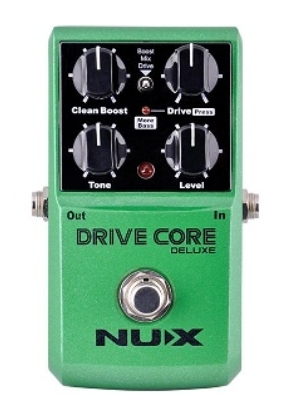
If you love smooth
and round sounds that keep this qualities when the gain knob is set high, you
can choose among a lot of soft-clipping pedals that are crowding the market. You
will find original reissues, clones and fine interpretations. They
are well suited to blues, fusion, pop, rock, in short to all genres, including
modern jazz. They are regularly used by shred guitar players to push the lead channel of the amp and facilitate legato and tapping techniques. They are usually
tailored to cut at best and pleasantly through the mix.
If instead you love ’70s rock music, straight and gritty distortion with
little compression and guitar faithful sounds, you will probably prefer hard-clipping overdrives. There are a lot of models for any
taste. They are usually played by heavy metal, hard rock, rock-blues
and fusion guitar players that aim for an aggressive
and biting sound. They are not so well suited for pop and melodic styles.
Outsider overdrives
as the Hot Tubes and the Centaur are good for guitarists searching for alternative and personal tones. In the
case of the Hot Tubes and similar pedals, dynamic and sonic attitudes are close
to an old tube amp (including flaws). In the case of the Klon and some of its great,
ahem, clones, ability
in using pedal, guitar, amp controls is required. The sound is neutral, greedy of gifts, very
responsive. Basically, what is there at the pedal input comes out
without a big help in modifying the sound paste. A good guitar and a good amplifier
are required.
Tube
overdrives
It seems there are not so many members in the tube overdrive category, but actually
they are not so rare. Over the decades a lot of models have entered the market.
The most famous is surely the late ‘70s progenitor Tube Driver. Technician
Brent K.Butler originally designed it to make its keyboard distort as Jon Lord’s
Hammond organ with The Deep Purple. The pedal that resulted from that
design was sold under the Chandler and Tube Works brands, and has been often
imitated.
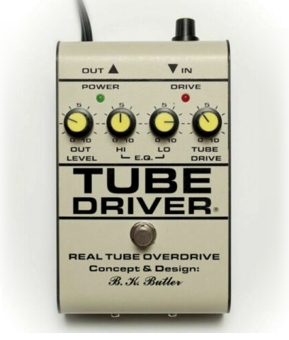
Other well known tube overdrives are the 1996 Ibanez Tube King, the milder Plush Valve Job by Fuchs and early 2000s Damage Control (Strymon today) large
pedals, that were at the limits of size and functions of real floor preamps such as the
ones built by Mesa/Boogie, Soldano or Brunetti.
How to use tube
overdrives?
Tube overdrives often are bulky and also need a specific power supply – if not a wall
socket – because of one or more tubes inside them. Sometimes they can work with
the 9V voltage and requested current supplied by an external power unit, but never by a battery. You must consider
this when you think of integrating them in a pedalboard.
At its best the overdriven sound actually is an overloaded preamp tube sound, but this does not mean this is what we are
searching for: hot, compressed, beveled in the treble range, think to Eric
Johnson or Kenny Wayne Shepherd. It is great for bending and legato techniques.
In other cases, it is more about donating warmth
to a solid state generated clipping. In order to understand which type you are
facing, a sign is given by its power supply: 9 Volts usually means the tube
hardly has a big influence on sound. Try before you decide: you could find your
own dream overdrive, or no longer want to know about it!
Fabrizio Dadò
References:
Guitar Player
Magazine #274 - October 1992 (Miller Freeman Publications)
